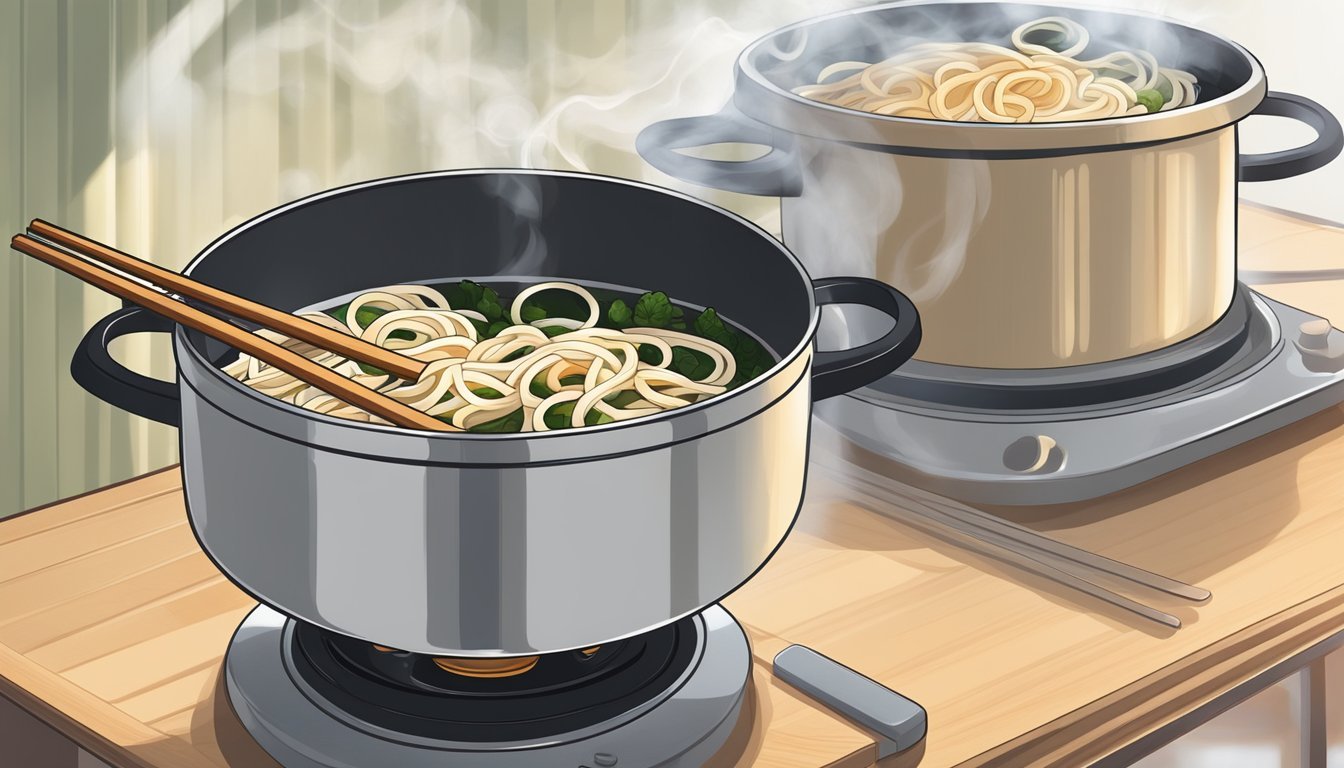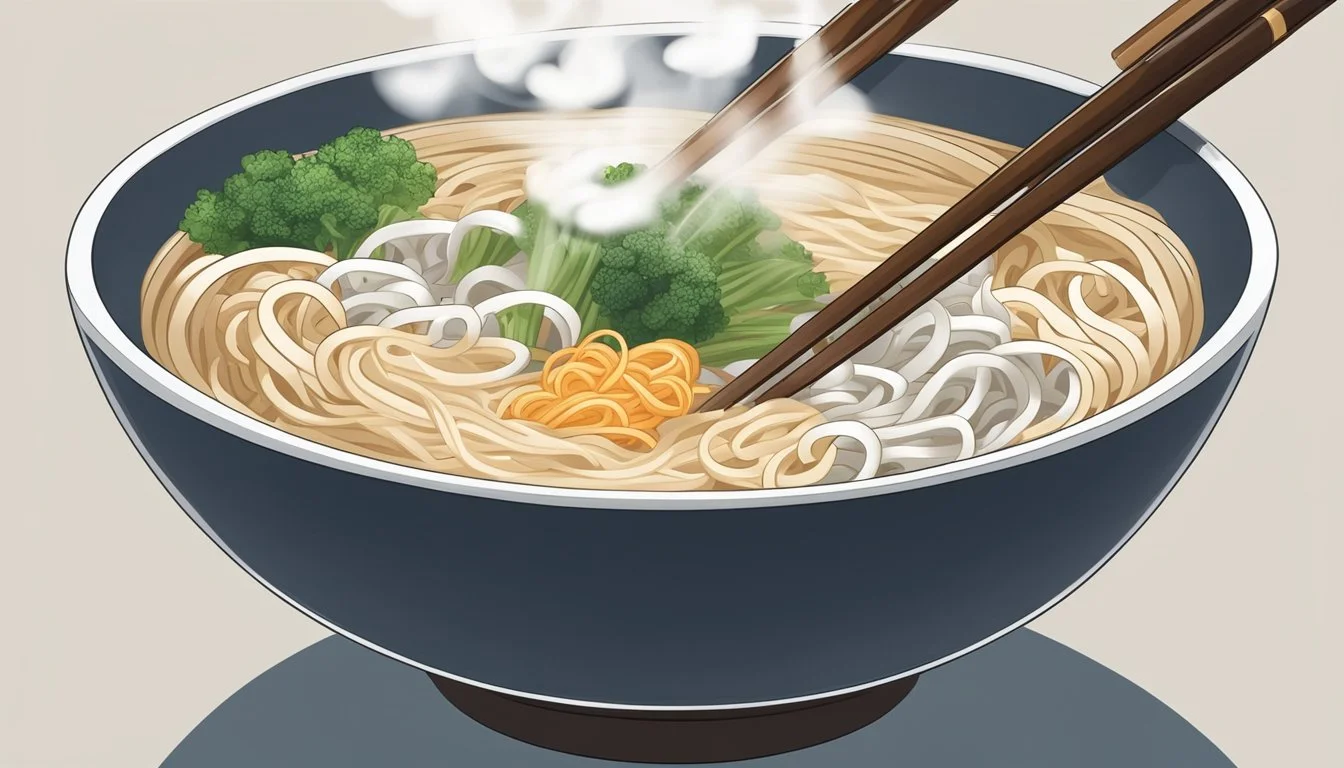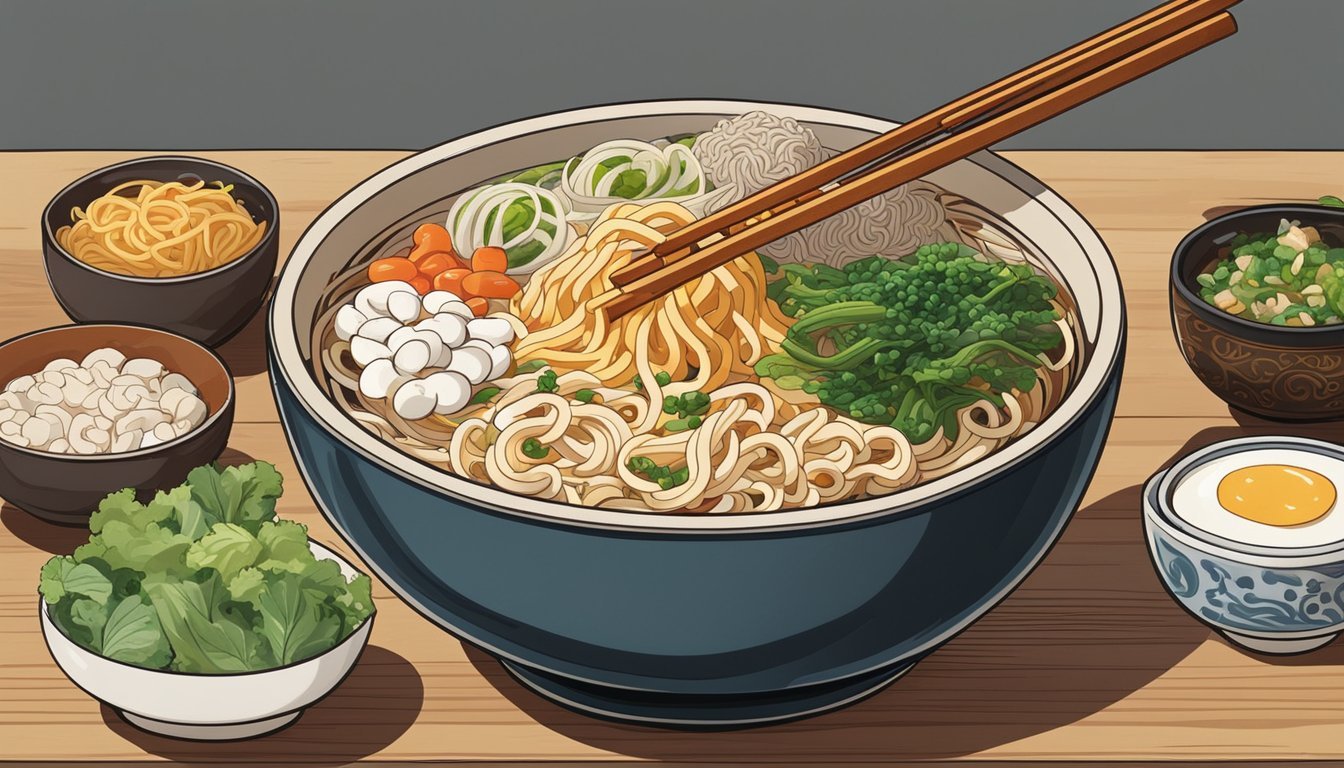Best Way to Reheat Udon Noodles
Ensuring Tender Strands and Piping Hot Broth
Udon noodles are a beloved element of Japanese cuisine, appreciated for their thick, chewy texture and versatility. Udon can be served cold in traditional summer dishes or warm in a comforting broth, making them a staple in a variety of meals. However, the key to maintaining the satisfying quality of udon lies in the proper technique of reheating. This is especially important when one aims to preserve their tenderness and ensure the accompanying broth stays hot and flavorful.
Reheating udon noodles requires a delicate balance to prevent them from becoming overly soft or mushy. The process differs slightly from reheating other pasta, as udon's unique properties demand specific measures. Whether the noodles are leftover from a previous meal or prepared in advance, it's crucial to apply the right reheating method to achieve the ideal texture and temperature. This task is not as daunting as it seems, and with a few precise steps, the noodles can be restored to their freshly cooked glory.
Maintaining the integrity of the udon's texture while bringing the broth to a satisfying warmth involves controlled heating and a bit of culinary finesse. It's not just about heating; it's also about ensuring the noodles are evenly warmed through without compromising their quality. By understanding and applying these crucial techniques, one can easily enjoy restaurant-quality udon at home, turning leftovers into a dish that's just as enticing as it was when first prepared.
Understanding Udon Noodles
Udon noodles are a staple in Japanese cuisine, characterized by their thick, chewy texture. They are traditionally made from wheat flour, water, and salt, though the specific ingredients and proportions may vary.
There are several types of udon, such as Sanuki udon, known for its square shape and flat edges, contributing to a distinct mouthfeel. When it comes to purchasing udon, consumers can find them in various forms including fresh, dried, and frozen. Fresh udon noodles are often preferred for their soft texture, while frozen udon noodles have the advantage of a longer shelf life and can retain a quality similar to fresh noodles when cooked properly.
The preparation of udon involves mixing and kneading the dough, rolling it out, and cutting it into strands. The dough is then cooked in boiling water until the noodles are tender. It is crucial to cook udon in a plentiful amount of water to prevent them from sticking together and to ensure even cooking.
Udon noodles are versatile and can be used in a variety of dishes ranging from soups to stir-fries. They absorb flavors well, making them an excellent medium for both bold and subtle sauces and broths.
When seeking high-quality udon, consumers may visit Asian grocery stores where there are typically more options available. Whether purchasing fresh or frozen, the quality of the udon can significantly impact the taste and texture of the final dish, advocating for a careful selection process.
Preparation Before Reheating
Before diving into the reheating process, it's crucial to prepare your udon noodles to maintain their texture and enhance their flavor. This involves proper handling of leftovers, thawing if necessary, selecting appropriate utensils, determining the best reheating method, and considering flavor enhancements.
Handling Leftovers
To preserve the quality of leftover udon, they should be stored in an airtight container to retain moisture and prevent them from drying out. If the udon noodles are clumped together, it's advisable to gently separate them before storing.
Thawing Frozen Udon
Frozen udon needs to be thawed carefully to ensure the noodles do not become too soft. Transfer them from the freezer to the refrigerator several hours before reheating, or submerge in cold water for a quicker thaw while retaining their firmness.
Choosing the Right Utensils
The right utensils make a difference in heating udon noodles evenly. Use a microwave-safe bowl if using a microwave, a pot for boiling, or a non-stick pan on the stovetop. Tools like chopsticks or a fork can be helpful in separating noodles during reheating.
Selecting a Reheating Method
Opt for a method that suits your texture preference and convenience. The microwave is quick, while the stovetop allows for better control over the heat. If using a pan, ensure it's heated first before adding the udon to prevent sticking.
Seasoning and Flavor Enhancement
Enhance your udon's flavor by adding seasonings like soy sauce, salt, mirin, dashi, miso, sugar, or sake. For udon soup, ensure that the broth is reheated separately to a simmer before combining with noodles to keep the flavor intact and the noodles tender.
Reheating Udon Noodles
When reheating udon noodles, it's important to maintain their tender texture while ensuring the broth remains hot. The following methods cover various reheating techniques tailored to achieve the best results for udon noodles.
Using a Microwave
To reheat udon noodles in the microwave, place the noodles in a microwave-safe bowl along with a splash of water to keep them moist. Cover the bowl with a lid or a microwave-safe plate to create steam. Heat on high power in 30-second bursts, stirring gently in between to distribute heat uniformly without compromising the noodles’ chewy texture.
Stovetop Reheating
For stovetop reheating, a non-stick pan is preferable. Add a small amount of cooking liquid, either water or the noodle's original broth, to the pan. Introduce the udon noodles and heat over medium flame. Stir-fry the noodles gently, incorporating a drizzle of sesame oil to prevent them from sticking together while restoring their tender, chewy consistency.
Oven As a Reheating Option
Although less conventional, the oven can be used for reheating udon noodles. Preheat the oven to a moderate temperature to avoid drying out the noodles. Place the udon in an oven-safe dish, lightly toss with oil, and add a few tablespoons of water or broth. Cover with foil and heat until warm, being cautious not to overdo it as prolonged heating can affect the noodles' texture.
Preventing Noodles from Sticking
One key aspect of reheating udon noodles is ensuring they do not stick together. Whether employing a microwave, stovetop, or oven, incorporating a small amount of oil or water is essential. During the reheating process, stirring the noodles gently can help preserve their distinct, chewy quality and prevent them from forming clumps.
Serving Reheated Udon
When serving reheated udon, it's crucial to guarantee a balance between the perfect noodle texture and the optimum broth temperature, complemented with a range of garnishes and sides for a complete dish.
Adjusting the Broth Temperature
One should ensure the broth for udon noodle soup is hot without being boiling, as excessive heat can continue to cook the noodles and risk turning them mushy. Bringing the broth to a gentle simmer provides a savory experience without compromising the noodle's texture.
Adding Toppings and Garnishes
After reheating, quickly add the garnishes to the broth to maintain their texture and flavor. Common toppings include:
Scallions or green onions for a fresh bite
Nori strips for a subtle sea flavor
Sesame seeds for a crunchy texture
Bonito flakes for a burst of umami
Delicate tempura pieces placed on top just before serving, to keep them crisp
Ensuring Udon Noodles are Al Dente
Udon noodles should be tender yet maintain a chewy texture, or al dente. They should not be overheated or they will lose their characteristic smooth texture. To achieve this, one can briefly dip the udon noodles in boiling water for just 30-60 seconds before adding them to the broth.
Pairing with Proteins and Vegetables
Pair udon with a variety of proteins and vegetables such as thinly sliced chicken, beef, or seafood like shrimp to add heartiness. Vegetables such as carrots or bok choy can be blanched or sautéed and added to the dish for a balanced meal. For vegetarians, cubes of fried tofu are an excellent protein addition.
By adhering to these guidelines, one can present a well-prepared bowl of udon noodle soup that is flavorful, comforting, and satisfying.
Creative Variations of Udon Dishes
Udon noodles offer a versatile base for creating a range of dishes that can match any dining occasion, whether it's a casual stir-fry or a sophisticated noodle soup. Below are creative ways to prepare udon that truly show off its adaptability.
Udon Stir-Fries and Salads
Stir-fried udon is an encounter of textures and flavors, forging a dish that's hearty and satisfying. For a basic yet tasty udon stir-fry, start with oil in a wok or a large pan over high heat. Sauté vegetables such as bell peppers, snow peas, and carrots, before adding the udon noodles. A splash of soy sauce or oyster sauce introduces a rich umami element to the dish. One can also integrate protein like chicken, shrimp, or tofu to enhance the meal.
On the other hand, udon salads are an excellent option for a lighter fare. Cold udon noodles tossed with a mixture of crisp vegetables, a tangy dressing, and a hint of citrus provide a refreshing yet fulfilling option. Sesame oil, rice vinegar, and a hint of ginger can serve as the foundation for a flavorful dressing that complements the chewiness of the noodles.
Adding International Flavors
These Japanese noodles are not confined to traditional Asian flavors; they can easily be integrated into international dishes. Udon noodles can replace pasta in Italian recipes, bringing a satisfying chewiness to the meal. Imagine udon coated with a robust pasta sauce and melted cheese, or perhaps prepared with garlic, olive oil and herbs for a simple, yet cosmopolitan dish. Inclusion of global ingredients and sauces can transform the familiar udon into an internationally-inspired delight.
Incorporating Udon into Soups and Stews
Udon's supple texture makes it a prime candidate for various soups and stews. For a comforting noodle soup, udon fits perfectly into a simmering broth of dashi, miso, or even a hearty chicken stock. Soups like kake udon, where noodles are immersed in a hot broth, highlight the noodle's capacity to absorb and accentuate the flavors surrounding it. A lively miso variant might include vegetables and tofu, creating a rich, multilayered experience.
In stews, udon can absorb the pronounced flavors from the braising liquid, be it a savory soy-based sauce or a spicy curry, resulting in noodles that carry the dish's essence in every bite. When reheating these dishes, warm the broth separately and combine with the noodles to maintain the optimal flavor and texture.
Tips for Perfect Udon Every Time
Achieving tender udon noodles and hot, flavorful broth is an art that hinges on precise reheating techniques and proper storage. Below are focused strategies to ensure udon noodles retain their ideal texture and the broth its intended taste.
Avoiding Common Mistakes
One must not overcook udon noodles as they are prone to becoming mushy. When reheating, they should be warmed just until hot to preserve their signature chewiness. It's advisable to reheat the broth separately and combine it with the noodles only before serving to maintain the optimal texture and thickness of the noodles.
Cooking Tips:
Boil udon noodles until al dente, then rinse in cold water to halt cooking.
Reheat noodles in simmering water for no more than 30 seconds.
Storage and Preservation Tactics
The proper storage of udon noodles is as critical as their cooking. For best results, one should store cooked udon noodles in an airtight container in the refrigerator and consume them within two days. If freezing, ensure that the udon noodles are well-separated and stored in a moisture-free bag to prevent ice crystal formation that can impact texture upon reheating.
Storing:
In the Fridge: Airtight container, consume within 48 hours.
In the Freezer: Sealed, moisture-free bag.
Enhancing with Fresh Ingredients
One's reheated udon can be greatly enhanced with the addition of fresh ingredients. Incorporating items such as green onions, thinly sliced carrots, or scallions at the end of the reheating process can not only add a crunch for texture contrast but also freshen up the overall flavor profile of the dish.
Freshness Tips:
Add green onions or scallions in the final 30 seconds of reheating.
Consider quick-cooking vegetables like carrots for an added crunch.
By following these detailed approaches, anyone can revel in a bowl of udon noodles that are just as delightful as when they were first prepared.





